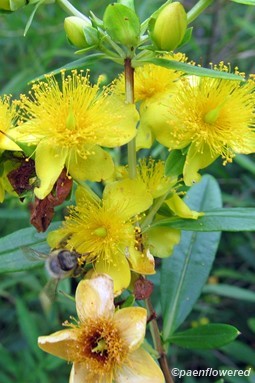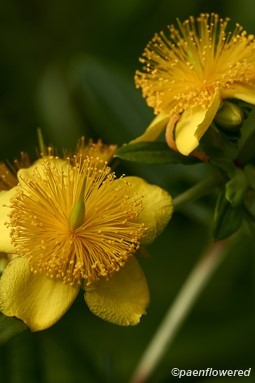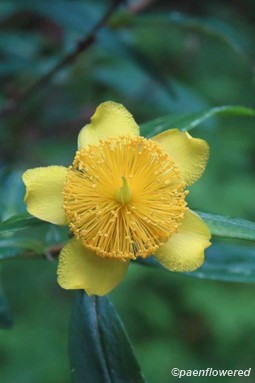Hypericum prolificum
A native St. John's-wort shrub with golden yellow flowers
Hypericum prolificum shrubby St. John's-wort
Add to MyPlants View Locations
This native perennial plant belongs to the same genus as the common St. John's-wort. It also belongs to the St.-John's-wort family of plants. Instead of being a herbaceous plant, this species, however, is a multi-branched deciduous shrub with woody 2-edged twigs, at least on the lower part of the plant. The bark on the woody branches tends to shred off. The upper stems are green and slightly winged on opposite sides. The plant grows 2-4 feet tall.
At the ends of the branches are clusters of golden yellow flowers, each up to one inch in diameter. Each has 5 petals, 5 small green sepals, a pistil, and many stamens. The stamens are so abundant that they tend to partially obscure the petals. This is another key feature of this species.
Bumblebees are the principal pollinators. The flowers only offer pollen as a reward to insects and produce no nectar. The fruit is a seed capsule with 3 compartments.
Shrubby St. Johnswort grows in fields and pastures and blooms from June to September. The peak season is July. It prefers full or partial sun and can grow in either moist or dry soils. It will tolerate rocky or sandy soils. It is found throughout the eastern half of North America. It is, however, endangered in New Jersey and threatened in New York State.
The shrubby St. Johnswort can be cultivated easily in gardens. A similar species called Kalm’s St. Johnswort (H. kalmianum) has narrower leaves and 5 styles and is found mostly on the shores of the Great Lakes. Plants in this genus have been used since ancient times for the treatment of wounds and inflammations.
Habitat & Range
Occasional in low fields, swamps and thickets.
Present throughout the state.
Range: Grows throughout the eastern half of North America. It is endangered in New Jersey and threatened in New York State.
| EMP: | FACU |
|---|---|
| NCNE: | FACU |
Phenology
Flowers July to September.
Identification Tips
Stamens can partially obscure the petals.
Plant Codes
S-rank: No Rank
G-rank: G5 (Secure)
Hypericum prolificum shrubby St. John's-wort
Synonyms: Hypericum spathulatumAdd to MyPlants View Locations











Comments
Have you spotted this plant in your area? We'd love to hear about your experience! Share your comments or questions about the plant below. Comments are moderated before posting.